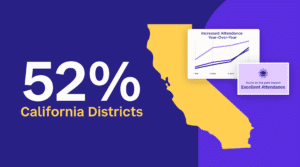
Featured Resource
Why Over Half of California School Districts Trust SchoolStatus
Read More >Join Mission: Attendance to reduce chronic absenteeism in 2025-26! >> Learn How <<






Darren Ralston, instructional coach with Albemarle County Schools in Virginia, explains the “Third Space” concept for building relationships and how a teacher and coach can use it as a “safe area” for their coaching interactions.
M
any outside of education understand just how taxing it is to teach other people’s children. The work of navigating disparate demands from administration, one’s department or team, families, and students can be maddening. On top of this, when you add the idea of trying to live your own best life with your own families, friendships, and all that comes with that, things can become very overwhelming.
For teachers, instructional coaching can sometimes feel like one more thing clouding the work they hope to do (e.g., yet another meeting to be had or another demand made). As coaches, most of us have been there and we know you’re in the thick of it right now. Perhaps you even need a coach yourself!
If we take a look at the issues prefaced above, we can start to pick apart this concept of a “Third Space.” Back in June 2018, I wrote a blog post on the Third Space where I put the ideas to page for the first time. Since then, I’ve done some reflecting and reading, and feel as though I’ve grasped a framework-based understanding of the concept that I would love to now share here.
There are numerous applications of the Third Space Theory, which cover postcolonialism to digital third spaces. Most iterations of the work recognize the cognitive—or even actual—establishment as a sort of “safe area” in which there’s no blaming or shaming, and in which some kind of growth can occur. Ultimately, it depends upon being able to develop and religiously maintain the necessary conditions for these boundaries to persist and function effectively.
To grasp this concept, we’ll have the teacher occupy the first space and the coach the second (or “other”) space throughout the post.

Depending upon the model that a coach operates within and whether that model is directive or opt-in, the distance between the teacher and coach can be characterized as suspicion, or perhaps curiosity. This distance can be one of many things that keep an “other” at arm’s length.
Frankly, one might think that these two spaces would want to gravitate towards each other until they look like a Venn diagram. However, we’re not looking at relationship building yet, because for coaching interactions it looks different compared to building a friendship.
A relationship formed without the use of the Third Space will focus on affinity and empathy, rather than the goal-work between a teacher and coach. However, this doesn’t mean that a teacher and coach shouldn’t engage on a personal level, because that’s part of trust building in a relationship. What this means is the relationship between the coach and teacher is a purposeful pairing, or grouping with something outside the familiarization of both parties to help them grow as the primary focus of a meeting.

As shown in the diagram, if the Third Space is present, the focus on self is diminished and the thing that occupies this new space is what the interest of each party is directed toward. As for the role of this position, it can be occupied by one of a variety of concepts, or variables, including cognitive areas, social-emotional practice, and territory.
A cognitive variable could be a new concept for study, adoption, and/or training that allows the opening of one’s mind to new practice. While this area is more academic than the others, that doesn’t mean it will always be a place of objectivity, which can lead to some interesting pitfalls. This is because when one is navigating a new concept that is different from a teacher’s current practice, it’s possible that the implementation of that concept may brush against that teacher’s sense of morality.
An example would be giving students 50% on incomplete work, versus 0%. For someone who believes in pulling oneself up by their own bootstraps, the 50% could seem like cheating their students of an opportunity for productive struggle. On the contrary, for someone who believes that grades are arbitrary and inconsistent, the 50% could seem like a safeguard from ruining students’ chances at passing a course. The thing to remember here is that we can presuppose that teachers with either perspective want to see their students succeed. This is an option for a solid Third Space, and provides a place for the work to occur so that the narrative can be reframed.
This area can be one of the most difficult, because it is very easy for the reflective work to become conflated with one’s sense of self, identity, morality, and ethics. The concept of socio/emotional practice operates through a teacher’s reflective work, in conjunction with the impartial audience of the coach. This space functions as a way to objectify the conversation, so that new realizations can be made, and real listening can occur without judgment, blame, or shame. This then leads to effective and targeted questioning guiding the teacher to new realizations and ideas.
However, if one’s not careful, work in socio/emotional areas can slide into places of affirmation if a coach is not careful in using non-judgmental language that favors neither the positive nor negative. Instead, the focus is only on the progress toward the specific topic or goal.
The territorial tends to blend into the other two, depending upon how metaphorical one goes with it. Because we’re defining borders between people, we can think of cognitive or emotional borders that can be transgressed. However, I include this because there are times where the actual space one functions in requires an extraction.
Think of the idea of walking through a doorway and forgetting what you came for. We have emotional and logical attachments to the purpose of physical place. Now, if a classroom is the place where a teacher is actively experiencing stress from a behavior management issue, perhaps it’s better to move to a neutral location. Conversely, working in the coaches’ office, or a space in the administrative offices, can be problematic for other associations of power differentials, or even how a coach is perceived in the given model. Meeting on a bench outside, in the lunch room, or even the library, can be a way to physically situate the conversation in a literal Third Space.
When we start from affinity and empathy, discussions tend to be more self-referential. To clarify, when adopting an affirmational stance, we’re starting the work in a place that connects to a sense of self in the teacher. While the work done in classrooms is inevitably tied to the teacher’s sense of self, the goal of the coach is to help the teacher grow professionally. If that professional growth occurs, we can then hope that some self-growth will occur in tandem or as a result of the outcomes.
When a coach starts from a place of affinity, the relationship between coach and teacher can be problematic because a critique, especially one made early in the coaching relationship, can become something taken “personally” rather than as related to the area of growth the teacher has defined. By dissociating the targeted or goal-based concepts from one’s sense of being (i.e., objectifying them in the Third Space), the work is much more defined, clear, and purposeful.
I’ll leave you with a diagram to this end showing a bridge of trust established between teacher and coach—as a result of successful work in the Third Space!

Darren Ralston is an instructional coach with Albemarle County Schools in Virginia. On top of being an instructional coach, Darren blogs weekly on his website (TheEdNarrative) about leadership, coaching, teaching, and sometimes just life in general. Also, he has his own podcast where he interviews educators through the lens of reflective conversation around pedagogy and praxis.
You can reach him via his website, or on twitter @theednarrative
{{cta(‘352a410e-db79-4f33-a482-d301e8041965′,’justifycenter’)}}
 SchoolStatusSchoolStatus gives educators the clarity and tools they need to get students to class and keep them moving ahead. Through our integrated suite of data-driven products, we help districts spot attendance patterns early, reach families in ways that work for them, and support teacher growth with meaningful feedback. Our solutions include automated attendance interventions, multi-channel family communications in 130+ languages, educator development and coaching, streamlined digital workflows, and engaging school websites. Serving over 22 million students across thousands of districts in all 50 states, SchoolStatus helps teachers and staff see what matters, act with speed, and stay focused on students.
SchoolStatusSchoolStatus gives educators the clarity and tools they need to get students to class and keep them moving ahead. Through our integrated suite of data-driven products, we help districts spot attendance patterns early, reach families in ways that work for them, and support teacher growth with meaningful feedback. Our solutions include automated attendance interventions, multi-channel family communications in 130+ languages, educator development and coaching, streamlined digital workflows, and engaging school websites. Serving over 22 million students across thousands of districts in all 50 states, SchoolStatus helps teachers and staff see what matters, act with speed, and stay focused on students.
News, articles, and tips for meeting your district’s goals—delivered to your inbox.






